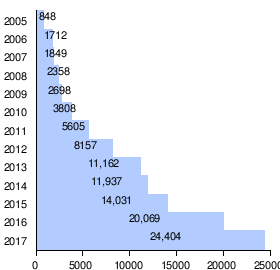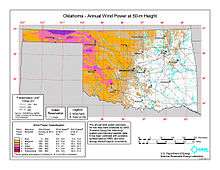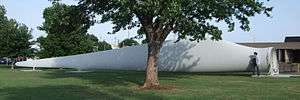Wind power in Oklahoma
The U.S. State of Oklahoma has high potential capacity for wind power in the western half of the state. In 2017, Oklahoma's installed wind generation capacity was almost 7,500 megawatts, supplying almost a third of the state's generated electricity.[1]
Growth
 |
| Million kilowatt-hours of electricity[2] |
 |
| Megawatts of Generation Capacity[3] |
Some of the wind farms in Oklahoma include:
- Blue Canyon Wind Farm 324 MW
- Centennial Wind Farm 120 MW
- Red Hills Wind Farm 123 MW
The $3.5 billion, 800 mile, Plains & Eastern Clean Line transmission line was approved in 2012, which will when completed in 2017 have the capacity to deliver 7,000 MW of wind power. As of April, 2017, Clean Line Energy Partners did not have any binding contracts to provide electricity to an electric utility. The only tentative, nonbinding, agreement Clean Line was able to obtain was for 50 MW of capacity.
In 2010 Oklahoma adopted a goal of generating 15% of its electricity from renewable sources by 2015.[4] Wind power accounted for 18.4% of the electricity generated in Oklahoma during 2015.[5] At the end of 2015, Oklahoma's installed wind generation capacity was 5,184 MW.[6] During 2017, wind power accounted for 31.9% of the electricity generated in Oklahoma, and installed capacity at the end of 2017 was 7,495 MW, the state being second in terms of installed capacity.[1]
In 2017, Invenergy and GE announced plans for the 2,000 MW Wind Catcher project in the Oklahoma Panhandle, which would be among the world's largest wind farms when completed in 2020.[7]
Potential

Being centrally located, the western half of Oklahoma is in America's wind corridor, which stretches from Canada into North Dakota and Montana, south into west Texas, where the vast majority of the country's best on-shore wind resources are located.[8] Oklahoma has the potential to install 517,000 MW of wind turbines, capable of generating 1,521,652 GWh each year. This is over one third of all the electricity generated in the United States in 2011.[9]
Economic benefits

Oklahoma's wind resources are the eighth best in the United States. The total number of direct and indirect jobs in the state from wind power development is estimated to be between 1,000 and 2,000.[10]
Oklahoma ended the half-cent tax credit for wind by July 2017. All zero-emission rebates were $60 million in the 2014 tax year.[11]
Wind generation
 |
| Oklahoma Wind Generation (GWh, Million kWh) | |||||||||||||
|---|---|---|---|---|---|---|---|---|---|---|---|---|---|
| Year | Total | Jan | Feb | Mar | Apr | May | Jun | Jul | Aug | Sept | Oct | Nov | Dec |
| 2014 | 11,937 | 1,176 | 745 | 1,182 | 1,251 | 957 | 1,097 | 782 | 781 | 875 | 901 | 1,188 | 1,002 |
| 2015 | 14,031 | 1,053 | 1,080 | 936 | 1,227 | 1,136 | 1,110 | 1,136 | 955 | 1,311 | 1,060 | 1,587 | 1,442 |
| 2016 | 20,069 | 1,423 | 1,763 | 1,990 | 1,728 | 1,701 | 1,380 | 1,725 | 1,234 | 1,506 | 2,062 | 1,719 | 1,838 |
| 2017 | 24,404 | 2,072 | 2,156 | 2,535 | 2,430 | 2,047 | 1,908 | 1,508 | 1,118 | 1,847 | 2,496 | 2,116 | 2,173 |
| 2018 | 16,073 | 2,732 | 2,349 | 2,833 | 2,870 | 2,494 | 2,795 | ||||||
See also
References
- 1 2 "Wind Energy in Oklahoma" (PDF). American Wind Energy Association. Retrieved 30 June 2018.
- ↑ "EIA - Electricity Data Browser, Table 1.14". U.S. Department of Energy. Retrieved June 30, 2018.
- ↑ "Wind Exchange: Installed Wind Capacity". U.S. Department of Energy. February 17, 2016. Retrieved June 30, 2018.
- ↑ "Oklahoma Governor Approves Energy Security Act". SolarIndustryMag.com. May 28, 2010.
- ↑ "U.S. number one in the world in wind energy production". American Wind Energy Association. Retrieved 7 April 2016.
- ↑ "AWEA". American Wind Energy Association. Retrieved 20 May 2016.
- ↑ "Invenergy and GE Renewable Energy Announce America's Largest Wind Farm" (Press release). GE. July 26, 2017.
- ↑ "80 Meter Wind Map". National Renewable Energy Lab. Department of Energy. Retrieved 12 May 2011.
- ↑ National Renewable Energy Laboratory (2012-07-04). "U.S. Renewable Energy Technical Potentials" (PDF). U.S. Department of Energy. p. 14.
- ↑ "State Wind Energy Statistics: Oklahoma". AWEA. Retrieved 22 May 2014.
- ↑ "Oklahoma governor signs bills to end wind incentive, airfield loophole". 18 April 2017. Retrieved 18 April 2017.
- ↑ EIA (July 27, 2012). "Electric Power Monthly Table 1.17.A." United States Department of Energy. Retrieved 2012-08-15.
- ↑ EIA (July 27, 2012). "Electric Power Monthly Table 1.17.B." United States Department of Energy. Retrieved 2012-08-15.
- ↑ Electric Power Monthly, February 2013, Energy Information Administration
- ↑ EIA. "Electricity Data Browser". United States Department of Energy. Retrieved 2018-07-30.
External links
| Wikimedia Commons has media related to Wind power in Oklahoma. |
